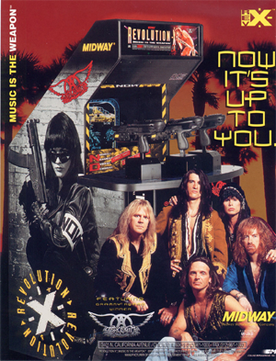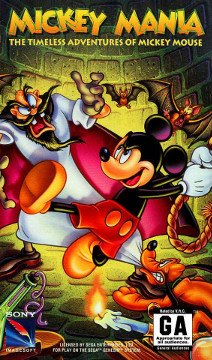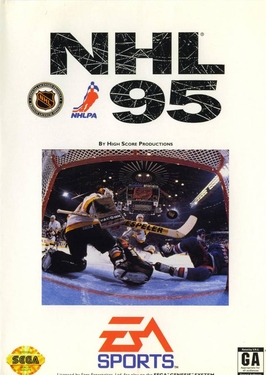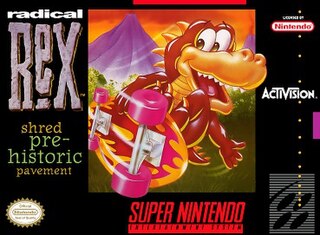
Earthworm Jim is a 1994 run and gun platform game developed by Shiny Entertainment, featuring an earthworm named Jim, who wears a robotic suit and battles the forces of evil. The game was released for the Sega Genesis and Super Nintendo Entertainment System, before being subsequently ported to a number of other video game consoles.

Revolution X is a shooting gallery video game developed by Midway and released in arcades in 1994. The gameplay is similar to Midway's earlier Terminator 2: Judgment Day, but is themed around the band Aerosmith. The oppressive New Order Nation regime and their leader Helga have abducted Aerosmith, and players use a mounted gun to control onscreen crosshairs and shoot enemies. The members of Aerosmith are hidden throughout the game's international locales and must be found in order to receive the game's true ending.

Venom/Spider-Man: Separation Anxiety is a side-scrolling beat 'em up video game and a sequel to Spider-Man and Venom: Maximum Carnage, released for Mega Drive/Genesis and Super NES and then ported to PC. One or two players team up as Spider-Man and Venom to defeat the evil symbiote Carnage. The game boasts many thugs that the player has to defeat: heavily armed Jury and Venom's symbiote children. There is also cameo assistance from Captain America, Ghost Rider, Hawkeye, and Daredevil.

Phantom 2040 is an animated series that is loosely based on the comic strip superhero The Phantom, created by Lee Falk. The central character of the series is said to be the 24th Phantom. It was aired from September 18, 1994 to March 3, 1996 in syndication.

Jungle Strike is a video game developed and published by Electronic Arts in 1993 for the Sega Genesis/Mega Drive. The game was later released on several other consoles such as the Super Nintendo Entertainment System (SNES), and an upgraded version was made for DOS computers. The Amiga conversion was the responsibility of Ocean Software while the SNES and PC DOS versions were that of Gremlin Interactive, and the portable console versions were of Black Pearl Software. It is the direct sequel to Desert Strike and is the second installment in the Strike series. The game is a helicopter-based shoot 'em up, mixing action and strategy. The plot concerns two villains intent on destroying Washington, D.C. The player must use the helicopter and occasionally other vehicles to thwart their plans.

Contra: Hard Corps, released as Contra: The Hard Corps in Japan and Probotector in Europe and Australia, is a run and gun video game released by Konami for the Sega Genesis in 1994, making it the first game in the Contra series released for a Sega platform.

Mickey Mania: The Timeless Adventures of Mickey Mouse is a 1994 platform video game developed by Traveller's Tales and published by Sony Imagesoft for the Super NES, Sega Genesis, and Sega CD. In the game, the player controls Mickey Mouse, who must navigate through various side-scrolling levels, each designed and based on classical Mickey Mouse cartoons. The game was later released on the PlayStation in 1996 as Mickey's Wild Adventure in PAL regions by Sony Computer Entertainment, Sony Imagesoft's successor. A second game, Mickey Mania 2, was intended to be released but was canceled due to Traveller's Tales focusing on other games.

Disney's The Jungle Book is a series of platform video games based on the 1967 Disney animated film of the same name. The game was released by Virgin Interactive Entertainment in 1994 for the Game Boy, Nintendo Entertainment System, Master System, Genesis/Mega Drive, Game Gear, Super Nintendo Entertainment System, and MS-DOS. While gameplay is the same on all versions, technological differences between the systems forced changes – in some case drastic – in level design, resulting in six fairly different versions of the 'same' game. This article is largely based upon the Genesis version.

The Lion King is a platform game based on Disney's 1994 animated film The Lion King. The game was developed by Westwood Studios and published by Virgin Interactive Entertainment for the Super NES and Genesis in 1994, and was ported to MS-DOS, Amiga, Game Gear, Master System, and Nintendo Entertainment System. The Amiga, Master System, and NES versions were only released in the PAL region. It is the final licensed NES game worldwide. The game follows Simba's journey from a young cub to the battle with his uncle Scar as an adult.

Brutal: Paws of Fury is a 2D fighting game published by GameTek in 1994. The game features a cast of various anthropomorphic animals as selectable fighters. It also features the ability to learn new attacks and save them via passwords. Originally a Sega CD exclusive, it was later ported to other game consoles.

Batman Forever is a beat 'em up video game based on the movie of the same name. Though released by the same publisher at roughly the same time, it is an entirely different game from Batman Forever: The Arcade Game. The game was followed by Batman & Robin in 1998, itself based on the movie of the same name.

NHL 95 is an ice hockey video game developed by Electronic Arts Canada. It was released in 1994 for the Super Nintendo Entertainment System and the Sega Genesis. The team rosters and player attributes in the game reflect that of the 1994–95 season.

Wolverine: Adamantium Rage is a platform-action video game released for both the Super NES and the Sega Genesis in 1994. The Genesis version was developed by Teeny Weeny Games, while the Super NES version was developed by Bits Studios. Both versions of the title were developed separately and differed from one another in some key areas, but their opening storyline and gameplay remain similar. It is one of the first video games to feature a recharging health system, though Wolverine has been able to recharge his health in previous X-Men games.

True Lies is a top-view run and gun video game based on the 1994 film True Lies. The game was developed by Beam Software and published by Acclaim Entertainment. Four different versions of the game were released for the Super Nintendo Entertainment System, Sega Genesis, Game Gear, and Game Boy. The home versions and portable versions are drastically different from each other, but have similar play mechanics.

Radical Rex is an action platforming video game released in 1994 in North America, Europe and Australia. It is a remake of the 1993 Game Boy game Baby T-Rex. It was published by Activision and developed by Australian game studio Beam Software for the Super NES, Genesis, and Sega CD. A Microsoft Windows port of the Super NES version published by Piko Interactive was released on March 7, 2019. Piko also released the game as part of the Piko Interactive Collection 1 for the Evercade on June 8, 2020.

PGA Tour 96 is a sports video game developed by Hitmen Productions for the PlayStation, MS-DOS, and Windows versions, Unexpected Development for the Game Boy version, NuFX for the Sega Genesis and 3DO versions, Ceris Software for the Game Gear version, and Polygames for the SNES version and published by EA Sports for PlayStation, MS-DOS, Windows, Game Boy, Sega Genesis, 3DO, Game Gear and SNES.

NBA Live 96 is the second installment of the NBA Live video game series published by EA Sports and released on November 30, 1995. The PC and PlayStation covers feature Shaquille O'Neal of the Orlando Magic, while the Super Nintendo Entertainment System, Sega Genesis and European PlayStation box covers feature a photo of the tip-off to Game 1 of the 1995 NBA Finals. PlayStation and PC versions are the first games in the series to feature 3D-rendered courts, allowing for multiple camera angles using EA's "Virtual Stadium" technology, which is also used for FIFA Soccer 96. On-court player graphics remain 2D sprites. It is also the first NBA Live game released for the PlayStation and the only game for the Game Boy. NBA Live 96 is followed by NBA Live 97.

Krazy Ivan is a mecha first-person shooter video game developed and published by Psygnosis. It was released for Windows, Sega Saturn and PlayStation in 1996.

FIFA Soccer 96 is a football simulation video game developed by Extended Play Productions and released by Electronic Arts in 1995. It was released for the Mega Drive/Genesis, Sega Saturn, Sega 32X, Game Gear, PlayStation, Super Nintendo Entertainment System, and MS-DOS compatible operating systems.

NFL Quarterback Club 96 is an American football video game released in December 1995. The game was released on the Sega Saturn, Sega Genesis, Game Boy, Sega Game Gear, DOS, and Super Nintendo Entertainment System. The game's cover features San Francisco 49ers quarterback Steve Young passing while being tackled by Chicago Bears defensive linemen Chris Zorich and Albert Fontenot. The Saturn, Genesis, SNES and DOS versions were developed by Iguana Entertainment, while the Game Boy and Game Gear edition was developed by Condor Inc.



















